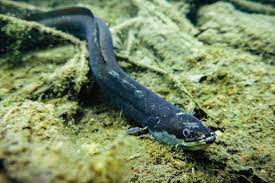Italy: Conservationists aim to save critically endangered European eels on Po River

Rome: European eels (Anguilla anguilla) are critically endangered, their population having plummeted by 97% since 1980.
Illegal fishing, dams and other barriers to their migration, droughts, pollution and habitat changes are putting the eels’ survival at risk.
These eels reproduce once in their lifetime, only in the Sargasso Sea, where they die. Their unique lifecycle and migratory pattern further complicates conservation efforts.
In Italy’s Po River Basin, researchers are working to conserve eels through interventions including the construction of fish passages to defragment rivers, reproduction in captivity and teaching fishers to recognize and release the likeliest breeders.
OASI DI CANNEVIÉ, Italy — In the early morning haze, Luca Bellini steered his green boat through the web of canals and lagoons of the Po River Delta. He had just pulled the fyke nets after 12 hours in the water so biologist Mattia Lanzoni could check for baby eels entering the Po from the sea. Sifting through the catch in water-filled basins, Lanzoni looked for the 6-centimeter- (2.4-inch-) long babies, called glass eels for their transparent bodies.
Their work is part of the monitoring efforts of LIFEEL, a public-private project focused on the long-term conservation of European eels (Anguilla anguilla) in the Adriatic Sea, with efforts on the Po in Italy and the Nestos River in Greece.
The Po Delta, located where the Italian boot meets mainland Europe, is one of the most important habitats for European eels and the longtime heartland of eel fishing, a practice that is now slowly fading. For centuries, fishers have trapped adult eels heading out to sea and other migratory fish in the delta’s brackish waters, using massive V-shaped weirs called lavorieri. They also trap juvenile migratory fish to raise to adulthood in lagoons, a practice known as valliculture.
“The elderly used to say that by placing a trap made of rushes in the water you would catch hundreds of glass eels,” Bellini said from his boat. “Now you struggle to see them.”
Eels in a traditional bolaga, jars immersed in water.
Eels in a traditional bolaga, a jar immersed in water for storing eels. Image by Lucrezia Lozza.
Since 1980, the European eel population has declined dramatically, by 97%. In 2008 the species joined IUCN’s Red List as “critically endangered”. Other species of Anguilla are under threat worldwide.
On the day of Mongabay’s visit in March, Lanzoni found no glass eels. Overall, the monitoring, which takes place from February to April, portrays a bleak picture. “The density of the upriver ascent of juveniles is drastically decreasing,” Lanzoni said, carefully checking the basins.
In spring 2021, after 33 days of monitoring with two nets, Lanzoni’s team recorded only 24 glass eels; recruitment was two orders of magnitude lower than in 2014 and 2015. In 2022, 23 days of monitoring with four nets turned up only 34.
Habitat loss due to fragmented riverways, climate change, drought and pollution are among the causes of the eels’ population collapse. Some legal fishing of glass and silver eels still occurs. But above all, illegal fishing of glass eels is to blame. According to Europol, the smuggling of live glass eels to Asia for aquaculture purposes is one of the most lucrative illegal wildlife trades, with around 100 metric tons of glass eels smuggled annually out of Europe at prices of several thousand euros per kilogram. While they can’t stop the smuggling, LIFEEL researchers are working to reduce other anthropogenic threats to eels.
The eels’ lifecycle covers thousands of miles underwater. In winter, sexually mature eels migrate from European rivers across the Atlantic Ocean to the Sargasso Sea in the Antilles to spawn and die. The resulting eggs drift eastward across the Atlantic, changing over a period of six months to one year into larvae called leptocephali, and reaching Europe after around three years.
“They feel the ‘call’ of the fresh water of fluvial transition areas,” Lanzoni said. “Instinctively, following the historical routes of the currents, of terrestrial magnetism, eels enter fresh waters.”
Growing in brackish and freshwater habitats where they spend most of their life, glass eels undergo another metamorphosis, taking on a yellow pigmentation. Then, after an average of 15 years, they metamorphose into silver-bodied adults, called silver eels, and feel another “call.” This time it’s seawater beckoning them to their last migration, westbound to the Sargasso.
Because eels live in several habitats — the sea, brackish waters, lagoons and rivers — they experience environmental pressures in each one. In 2022, the worst drought in 70 years gripped the Po River, and it has persisted at least until devastating floods hit northern Italy in May 2023. Riverside refuges and nurseries, usually flooded and lush with aquatic vegetation, were dry.
“Lacking the buffer zones used during their ascent, eels are pushed into the central section of the river where there is no vegetation and are further exposed to predators, with greater biological stress,” Lanzoni said.
While the delta is naturally in constant flux, the persistence of the drought led to habitat changes. From his boat, Bellini pointed at seaweeds that shouldn’t be growing in the riverine canals and at the water, too clean. He is a vallante, employed by LIFEEL to manage 70 hectares (173 acres) of marshy territory. He keeps watch over the seasonal fish movements and is the first to spot any signs of stress. In part of his territory where the land is lower than the sea, he also manages the fragile equilibrium between fresh water and salt water by regulating sluice gates and siphons. But droughts and the intrusion of salt water from the sea into the river have made his job increasingly difficult.
“The right salinity in the environment must be kept, but too little fresh water comes down from the Po,” Bellini said. Last year and this winter were “a disaster,” he added.
Saltwater intrusion is natural in the river delta. While seawater pushes inland, fresh water flows toward the sea, remaining above the denser seawater. When hit by drought, the river flow slows, letting the seawater push farther upriver and into the water table.
In the 1950s, saltwater extended about 3 kilometers (1.9 miles) upriver from the delta’s mouth. In 2022, however, it reached 30 km (19 mi) upriver in some areas. Entering the aquifers, saltwater burns the land, curtailing agricultural production. It also impoverishes the diversity of habitats the eels need. Spending more time in saline environments is altering eels’ development and increasing their exposure to marine predators, Lanzoni said.
A scene on the Po Delta, located where the Italian boot meets mainland Europe, is one of the most important habitats for European eels and the longtime heartland of eel fishing in Italy. Image by Mattia Nocciola.
Map showing the Po basin and the various monitoring regions.
As eels at various life stages move through the river system, they encounter other obstacles. The Po and its tributaries are broken with dams and other barriers: 79 along 10 of the Po’s main catchments, of which 48 were impassable to eels, according to a 2013 assessment by GRAIA, a Varese-based hydrological research company and LIFEEL project partner. The problem goes far beyond the Po. There are at least 1.2 million instream blockages in 36 European countries, according to a 2020 paper.
In fragmented rivers, eels can’t reach habitats they use to feed and grow, escape from predators or when they are sexually mature, return to the sea. “Transversal infrastructures lacking adequate artificial fish passages fragment the river network,” Cesare Puzzi, a veterinarian with GRAIA, told Mongabay. Puzzi is working to restore connectivity by coordinating the construction of six passages at key points on the Po and its first tributary in from the sea, the Panaro River.
Five of these passages will allow eels and other fish to migrate past barriers via a system of pools and weirs. A sixth passage at the Chiusa di Valpagliaro sluice gate will use a plastic rug-covered climbing ramp designed specifically for juvenile eels. The passages are in various stages of tendering and early construction.
The biggest of the Po’s existing fish ladders sits at the Isola Serafini hydroelectric dam, 300 km (186 mi) inland. After its construction in 1960, the dam divided the waterway, compromising riverine biodiversity for decades. Opened in 2017 as part of an earlier defragmentation project GRAIA supported, a 645-meter- (2,116-foot-) long passage lets fish surmount the 20-meter- (66-foot-) high dam by passing through a series of large basins, each stepped 25 cm (10 in) higher than the one before.
“We saw adult eels descending,” Puzzi said, but it will take time for young eels to ascend upstream again after decades of interruption.
Hydroelectric dams pose other risks, too. Their turbines are death traps for eels, which get caught in the whirl and chopped apart. Because eels don’t like light, Puzzi’s team plans to place submerged strobe lights near the turbines of the Creva dam, between Lake Maggiore and Lake Lugano in Switzerland, hoping to reroute the animals away from danger.





